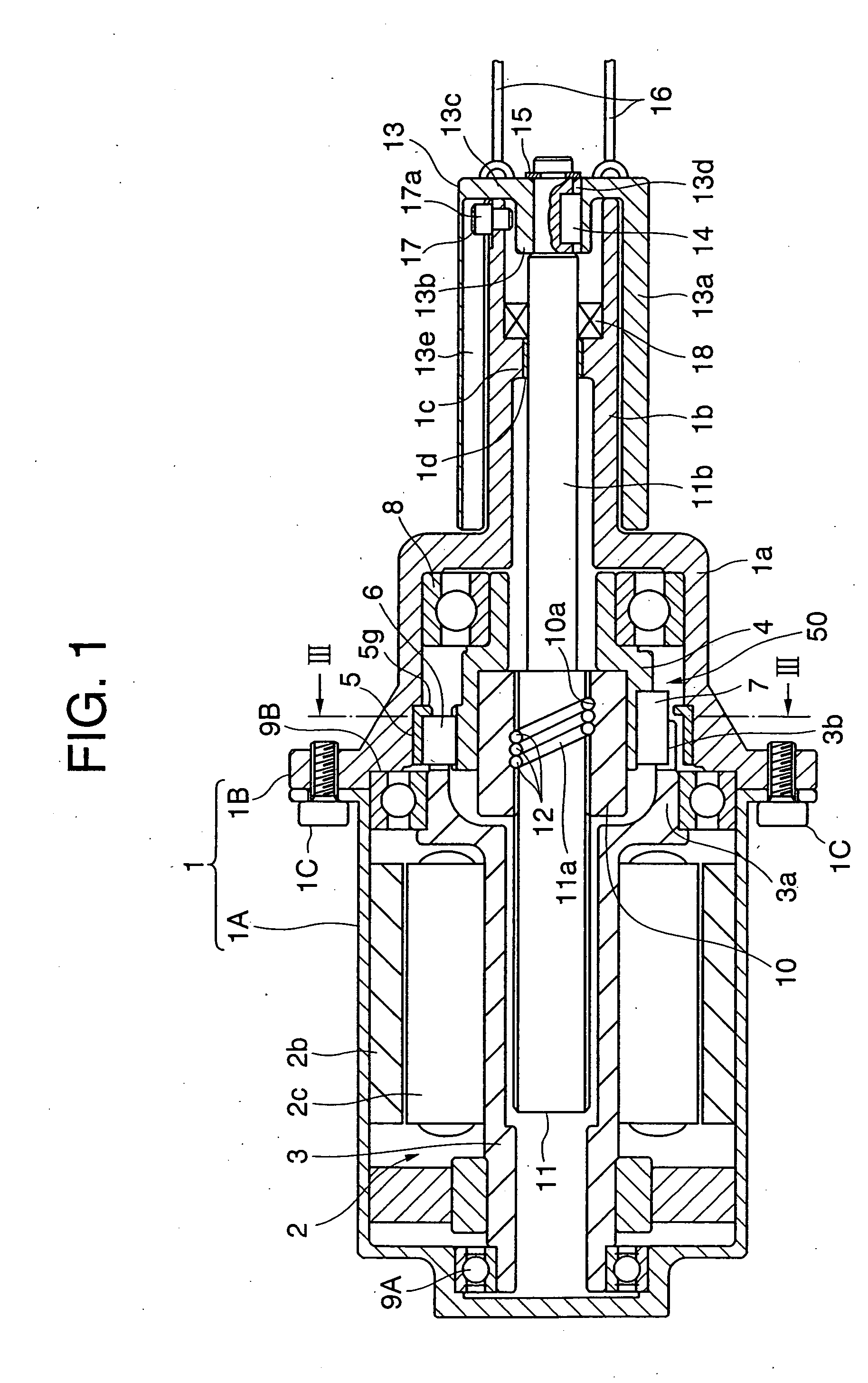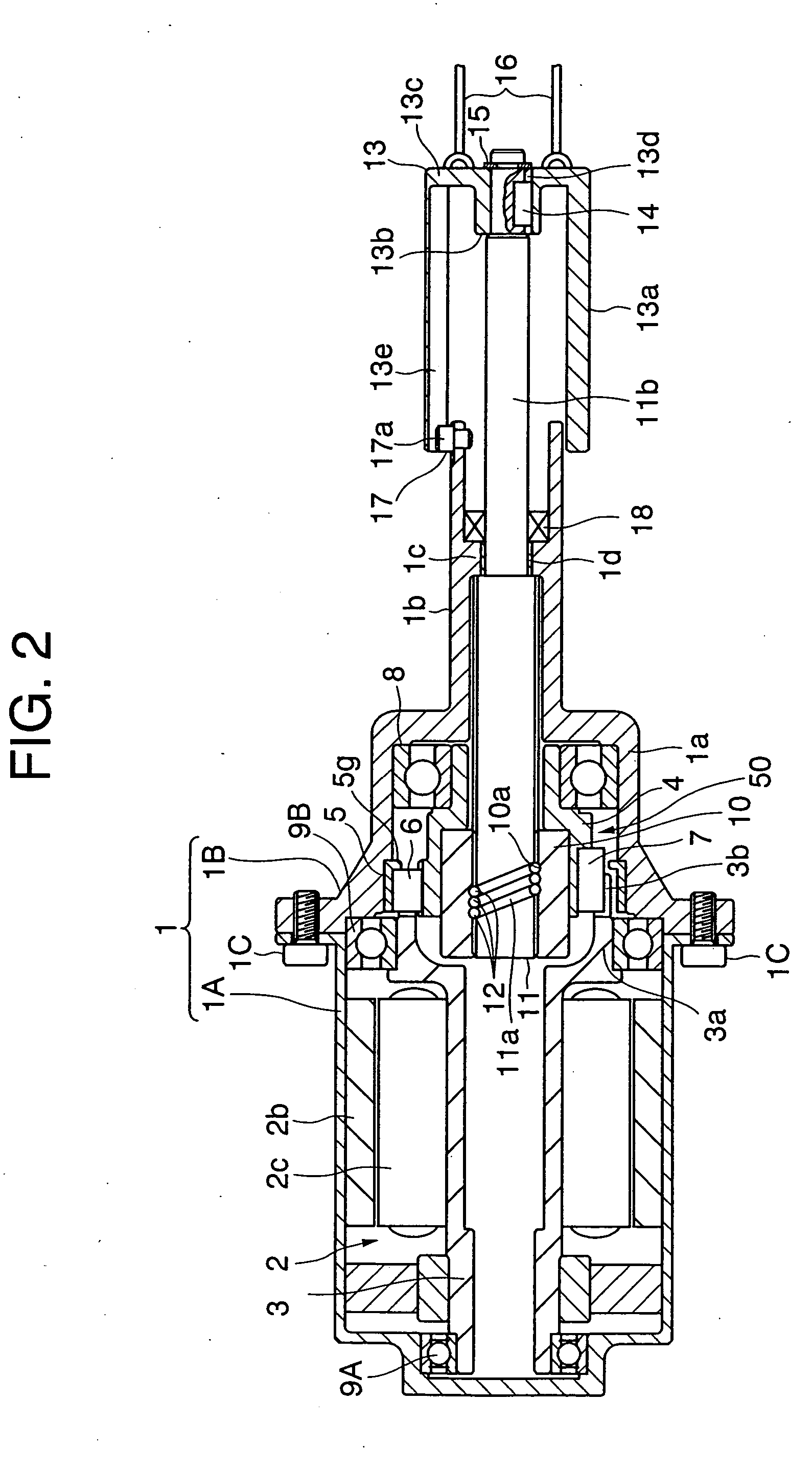Linear actuator
- Summary
- Abstract
- Description
- Claims
- Application Information
AI Technical Summary
Benefits of technology
Problems solved by technology
Method used
Image
Examples
first embodiment
[0068] Next, embodiments of the present invention will hereinafter be described with reference to the drawings. FIG. 1 is a sectional view of an electric parking brake drive apparatus when in a braking operation by way one example of a linear actuator in a FIG. 2 is a sectional view of this type of electric parking brake drive apparatus when released from braking. FIG. 3 is a view showing a construction cut off along the line III-III in FIG. 1 as viewed in an arrowhead direction.
[0069] In FIG. 1, housing 1 is constructed of cylindrical motor housing 1A and cylindrical main housing 1B that are connected to each other via a bolt 1C. A cylindrical stator 2b is fixed to an inner peripheral surface of the motor housing 1A, and embraces a rotor 2c. The rotor 2C is attached to an outer peripheral surface of a rotary shaft 3 of which a left side end is, as viewed in FIG. 1, rotatably supported via a bearing 9A with respect to the motor housing 1A, whereby the rotary shaft 3 and the rotor 2...
fifth embodiment
[0089]FIG. 8 is a sectional view of a linear actuator according to a FIG. 9 is an enlarged view of a portion indicated by an arrowhead IX in the construction in FIG. 8. FIG. 10 is a view of the construction as viewed in an arrowhead direction in a way that cuts off the construction along the line X-X.
[0090] In FIG. 8, main housing 101B taking a substantially cylindrical shape is fitted via an O-ring 101C in an aperture Ca of a box body C and is thus secured to the box body C together with cylindrical motor housing 101A by use of an unillustrated bolt. Housing 101 is constructed of the motor housing 101A and the main housing 101B. An electric motor 102 including a rotary shaft 103 defined as an output shaft is disposed inwardly of the motor housing 101A.
[0091] The rotary shaft 103 is rotatably supported via a bearing 109A with respect to the motor housing 101A at a left side end in FIG. 8. The bearing 109A is biased by a washer spring 120 toward a right side in FIG. 8 against the m...
sixth embodiment
[0117] In the sixth embodiment, when at least part (the pawl portion 203b within a range Y2 in FIG. 11) of the axis-directional engagement portion between the rotary shaft 201 as the rotation driving portion and the rotation driven member 204 as the rotation driven portion exists in a range (an axis-line-directional extension range Y1 of a tube 210c in FIG. 11) where the ball 212 of the ball screw mechanism (212, 210, 211) exits, it is possible to restrain an adverse effect that is exerted on the nut 210 by the moment generated at the engagement portion (the pawl portion 203b) due to an axis deviation between the electric motor 202 and the nut 210.
[0118] A power transmission mechanism 250 includes the rotary shaft 203 as the rotation driving portion, the rotation driven member 204 as the rotation driven portion, the outer race 205 as the fixing portion, and the ball screw mechanism (211, 210, 211) as a converting mechanism.
[0119] A construction of the power transmission mechanism 2...
PUM
 Login to View More
Login to View More Abstract
Description
Claims
Application Information
 Login to View More
Login to View More - R&D
- Intellectual Property
- Life Sciences
- Materials
- Tech Scout
- Unparalleled Data Quality
- Higher Quality Content
- 60% Fewer Hallucinations
Browse by: Latest US Patents, China's latest patents, Technical Efficacy Thesaurus, Application Domain, Technology Topic, Popular Technical Reports.
© 2025 PatSnap. All rights reserved.Legal|Privacy policy|Modern Slavery Act Transparency Statement|Sitemap|About US| Contact US: help@patsnap.com



